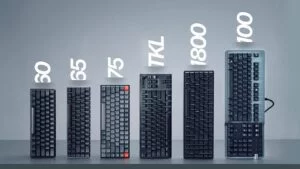How To Choose A Power Supply

Share:
Recently we had a chance to visit Be Quiet! headquarters in Germany. It’s very interesting to see how the products are designed and by whom, and how they are tested, with particular focus on power supplies and how they make sure to deliver a quality product. Arguably, power supplies are less exciting than let’s say graphics cards, but we PC users have an understanding that having a quality PSU is absolutely crucial. Therefore, Be Quiet! decided to sponsor this How To Choose A Power Supply article, but anything we discuss here can be applied to any power supply from any vendor.
One really interesting experiment I got to observe was with a particular system that had two AMD Radeon R9 295X2 graphics cards in CrossFire configuration running FurMark at 4K in order to stress the GPUs to 100% and push a 1000 watt power supply. It was actually being made to supply 1100 watts, which is pretty crazy and a good sign of quality. Sometimes you wonder why somebody would want a 1000 watt power supply, well it’s because there are occasionally two graphics cards that actually need all that power. Here’s a little interesting tidbit, after switching the resolution to 1080P instead of 4K – remember we were running four GPU across those two cards – power consumption dropped down to 443 watts. So it was pretty fascinating to see a whole system consuming 1100 watts with those cards, and then seeing how much lower the power consumption decreased just by dropping down the resolution.
How Many Watts Do You Need?
This is a perfect segue for how much power do you actually need. Many manufacturers like Be Quiet! have a PSU calculator on their website to get you started, and this will allow you to put in your components and it will calculate how much power is needed. The intent is not to get consumers to overbuy, but ensure that they understand that getting a bit of extra capacity from a PSU will certainly help with future upgrades. This is actually quite important for new builders, because I remember building my first system about seven years ago and thinking that I need a 1000 watts for a single GPU system. Obviously I didn’t totally understand what I was doing back then, but this whole system PSU calculator is a nice guide to finding out just how much power you need.

Power Supply Sizing
When it comes to size, normally this is not something to necessarily worry about as most modern cases have a nice large and open PSU section. However, some smaller cases will not fit large power supplies like the Dark Power Pro series, even though the case may be able to fit all kinds of high-end components. I have encountered some incompatibility with larger power supplies, and I would need to insert it on an angle because of how the frame is designed on some smaller cases, so that’s something to keep in mind. On the other hand, some smaller PSU’s – SFX in particular – may not have the necessary cable length to reach certain areas in a standard mid-tower or full tower cases, so the happy medium would be something like this to Be Quiet! Pure Power 11, which is 160mm in length, has a semi modular design, and is available up to 700 watts.

Power Supply Cable Length
Next up are the cables. It is particularly important to make sure the cables are long enough to fit your chosen case, and there’s usually a cable length chart – like with one below from Be Quiet! for example – where you can see exactly how long each of those cables are.
Normally with larger and more premium power supplies, you have slightly longer cables, which is great, but I would say cable lengths for all power supplies and case layouts have standardized to a point where you don’t really have to worry about the main connections like the 24-pin ATX power connector, the eight-pin CPU connector, and the six or eight-pin PCI-e connectors. However, I have encountered some SATA cables not being long enough to reach certain sections of the case. For instance, if you’re mounting a hard drive on one of the corners of the case, then it might be a difficult reach. It’s usually quite easy to bunch up any unused length, but for a larger enclosure like the Dark Base Pro 900 rev. 2 it is best to have very long cables to make sure to reach all parts of the enclosure. Also, are the cables braided or flat? I personally prefer flat cables when working inside ITX cases or when the spacing behind the motherboard is very tight. On the other hand, braided cables generally look better inside the main chamber, but are slightly chunkier.
Modular Power Supply Types
Next up is modularity, and they have three different types of fully modular units, one example is the Be Quiet! Straight Power Series. Every cable can be removed or added, and it’s interesting if you want a PSU with dual 8-pin CPU power connectors for future expansion but only need one right now. You do pay more for a fully modular I/O even though you always need certain cables like 24-pin and 8-pin CPU cable and most of the time at least one 6 pin PCIe. The disadvantage of a fully modular unit is, at least personally, I don’t use 60% to 70% of all the cables provided with the power supply, and they’re just left in the back somewhere. Secondly, because of how the connections are spread throughout the unit, it expands the length of the power supply.
Next up is a partially modular unit, the Dark Pro series for example. Most use connections like the 24-pin and the 8-pin CPU, and some GPU cables may be hardwired and can generally cost a bit less than the fully modular unit. The downfall is that if you don’t need some of those hardwired cables, then you will need to find a place to hide them. This can be an issue in some smaller cases.
For the non-modular units like the System Power from Be Quiet!, typically they are the least expensive option, so they help you remain within budget. You now have no modular cables, and the issue is that you have to find a place for a ton of cables. However, since everything exits from one side, you are essentially clearing up room for long graphics cards if the power supply is installed in the front the case, which happens to quite often for ITX systems. I actually prefer using a non-modular power supply in tiny cases so that I can clear up some extra space for a graphics card.
Power Supply Efficiency
Next up, let’s talk about efficiency, which is a key element in choosing a power supply. Efficiency is determined based on how much input power is needed to supply a given output power amount. For example, even though your components may require 400 watts, an inefficient power supply may need to draw up to 500 watts from the wall, while a more efficient one may only need 450 watts from the wall. Over time this can make a big difference. More efficient power supplies will run quieter and cooler because less of that power loss is converted to heat.
With power supply efficiency testing, we can estimate exactly how much wattage we will be consuming with a Gold power supply versus one with a Bronze efficiency rating. On a test system, with Prime95 and FurMark running at 100% and we were consuming just under 300 watts with a 650 watt power supply.
This is by measuring exactly how much we’re pulling from the wall. During the test, power usage did just jump over 300 watts of consumption and that was because the components are getting hot, they are getting less efficient.
Now to compare by switching out the Gold rated power supply for a Bronze efficiency model. This one is a 400 watt unit and we are running a Core i7-8700K and GTX 1070 Ti and stress testing them with Prime95 and FurMark, so we can take full advantage of 100% load on both the CPU and GPU. Hopefully we can see some efficiency differences between Bronze and the previous Gold one. With the Bronze efficiency unit, we were pulling close to 340 watts from the wall instead of 315 watts with a Gold efficiency unit. This was just a cool experiment to see the power draw increase as components get hotter, and also that whole efficiency variable between Bronze and Gold, and how in fact we were indeed consuming more power from the wall with a Bronze power supply.
80 Plus Certification
Next, let’s talk about 80 Plus certification. Typical efficiency for power supplies used to look like a bell curve chart. Here is a dramatization with a 1000 watt power supply as an example. What it shows is that typically at low and very high outputs efficiency is lower. There’s that sweet spot somewhere in the middle where efficiency is the highest, and this is bad because whatever capacity power supply you have, it will only operate at the peak efficiency in only a slim output range when it comes to load. 80 Plus basically sets that baseline minimum efficiency of 80% at different output levels. Titanium is the newest and it also adds a minimum rating of 10% output – which is to say that a Titanium power supply must still be 80%+ efficient even only 10% of its capacity is being used – this is pretty important for systems that are at idle a majority of the time.
Figuring out the Power Supply Label

Now for something actually quite important, understanding the label. This label here is from the Dark Power Pro 850 watts. Starting with the AC input at the top, it is rated for 100 volts to 240 volts, which means it can be used in both North America and the many countries that use 240 volt power. Below that will be DC output. What power supplies do is take your household AC current and convert it to five different DC voltages: 3.3 volts, 5 volts, 12 volts, -12 volts and 5VSB. We’ll talk about the first three voltages, since the 5VSB is used for system stability, and -12 volts is for some legacy PCI devices. Both the 3.3 volt and 5 volt outputs are used for SATA and molex connections, some controllers on a motherboard, as well as memory. It is able to output about 140 watts to those 3.3V and 5V outputs.
Typically, you don’t really need that much power for the 3.3V and 5V outputs as modern PCs generally require 12V power, which brings us to the 12 volt section. A high 12 volt value is very important since your most power hungry devices like the processor and graphics card require mostly 12 volt power. Some power supplies have a single 12 volt rail or partition, and in the case of our 850 watt power supply it has multiple 12 volt rails. Neither one is right or wrong, but in the case with our Dark Power Pro 850 watt you can see that each rail has either a 35 amp 420 watt limit or a 30 amp 360 watt limit. If more power than that is drawn from a single rail, then over current protection (OCP) will kick in. The likelihood of that happening is very slim, but it makes sense for overclockers and really anyone who is pushing their hardware – to have a single large 12 volt rail so you can really channel all that power towards the hardware and avoid having any of the power deficits that can occur on multi-rail power supplies when one rail is overtaxed.
One other thing to mention is that the over current protection on multi-rail power supplies could protect components in some situations. Meanwhile, a multi-rail design also follows the ATX spec while single rail units don’t. You can see in this example that almost all of the power supply’s power can be dedicated to a 12 volt rail – about 840 watts – and that’s a good thing when we’re overclocking and need to ensure that your main components get enough power. This whole label breakdown is actually quite important, and maybe check it out next time you’re buying a power supply to see what type of 12 volt rail configuration it has, a single large one or many of them . Also pay attention to how much power can be allocated for the 12 volt in total versus how much is going to the 3.3V and 5V rails.
Conclusion
We’re not telling you which power supply to buy in this article, but use all the guidelines we discussed today to help your buying decision. By the way, avoid all the bling like RGB lighting and wattage monitoring since all those kinds of things are useless for your power supply, and obviously they add to cost. Now the whole efficiency level for power supply is more important for high wattage that are running at load most of the time. That is not to say that you don’t need Titanium efficiency power supply for your single GPU system, but it’s just that the savings that you will get at the end of the year may not be significant. The immediate benefit is that your power supply will be running cooler and quieter versus something that has a lower efficiency rating. Definitely use the PSU calculator to see how much power your system really needs versus what you thought it might need.
Buy items in this article from Amazon at the links below:
[amazon_link asins=’B01FWUHOBA|B014QT9J5M|B014QT9J5M|B014QT9J0M|B014QT9J0M’ template=’DefaultTemplate’ store=’hardwar0d-20|hardwar06-20|hardwar04-21|hardwcanuc-21|hardwar00-21′ marketplace=’US|CA|UK|DE|FR’ link_id=’a0c59fe5-7310-4e93-8c4d-233dbfd4b602′]
[amazon_textlink asin=’B07CX3225B|B07CX3225B|B078X1J85L|B078X1J85L|B078X1J85L’ text=’Straight Power 11′ template=’DefaultTemplate’ store=’hardwar0d-20|hardwar06-20|hardwar04-21|hardwcanuc-21|hardwar00-21′ marketplace=’US|CA|UK|DE|FR’ link_id=’22153fff-b35c-44e6-b94d-25d59aa97782′]














